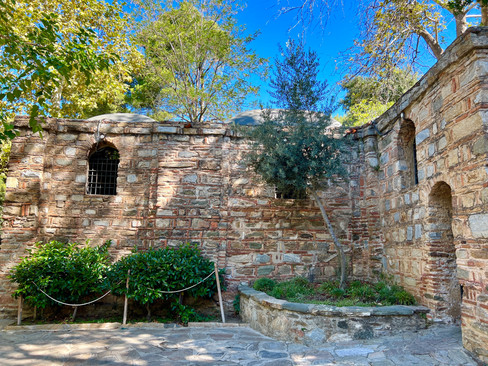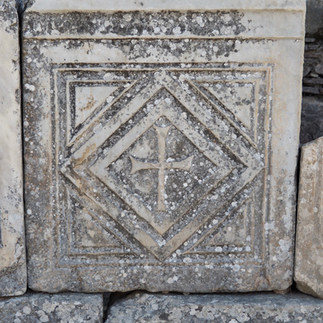Extraordinary Ephesus!
- sbcrosby .

- Sep 14, 2023
- 5 min read
I often think of things, after the fact, that I should have included in a previous day’s blog post. Here’s one of those things. Go back to the “It’s All Greek to Me” post and take a look at the pics of the Parthenon, specifically the close-up images of the corners. Do you see the pieces that look like Legos? Methinks the Danish company didn’t actually invent these little bare-foot-destroying building blocks after all – the Romans did!
One more thing before I record our day in Ephesus. Not all tours are equal, and not all tour guides are equal. We’re fortunate to have experienced many great tours in our international travels. We’ve also had some just-ok tours and a few really bad tours (think tuk-tuk tour in Zurich, right Hannah?!). Tuesday’s visit to the Acropolis in Athens was just an ok tour. Not terrible, not great. Being able to check the Parthenon off our bucket list, however, made up for our weak guide who added little value or color commentary.
To say that Wednesday’s tour made up for it would be an understatement! And to think we almost missed our opportunity to meet Zeynep our guide, due to an error (totally on my part) about the start of the tour. We showed up 45 minutes late – thinking we were 15 minutes early – and luckily, she was still waiting for us!
A native of Ephesus, Zeynep is a licensed tour guide (you must complete a four-year college degree for this in Turkey), and all 5 feet of her is full of energy, enthusiasm, and passion for her country and for her profession. We hit the jackpot of tour guides!

Our first stop was on the outskirts of town to the small cottage believed to be the home of Mary in the final years of her life. This serene place had a peacefulness about it and was surrounded by beautiful, mature olive and fig trees. The Bible mentions that Jesus entrusted his mother Mary to the care of the apostle John, who was known to have lived in Ephesus for many years until his death here at a very old age.
Next, we arrived at the ancient site of Ephesus, once considered the most important trading center in the Mediterranean. This site is actually the second location of the original city, and dates back to 300 BC when Alexander the Great defeated the Persians to take over the city. Shortly after, Lysimachus, one of his generals, renamed it Arsineia and moved Ephesus two miles away from its original location. In early 100 BC, Ephesus was willed to the Roman Empire from reigning King Attalus of Pergamon. Under Caesar Augustus’ reign, Ephesus actually experienced its most prosperous time – lasting until the 3rd century AD. In fact, many believe that Ephesus was second only to Rome as a cosmopolitan city of trade and culture.
These massive ruins are incredible, and there is enough for your imagination to paint a picture of this active and alive ancient city. Yet, incredibly, it’s estimated that only 10 percent of the original city has been excavated!
We came upon the remains of the aqueduct and clay pipes that originally served as the sources of water into the city. We also walked what was the wholesale marketplace – where traders sold their goods. A smaller theater was housed in this area. (Interesting fact: technically, an amphitheater is completely round or oval, with two sides. The word “amphi” means round or both sides. If the structure is a half-circle, it’s simply a theater. Thank you, Zeynep!)
As we walked along the pedestrian streets of this ancient city, you can almost picture the market “stalls” with people selling textiles, foods, pottery, and other goods. If you’ve been to Pompeii, it has a very similar feel.
We then made our way to the beautiful Library of Celsus – one can only imagine how ornate the original structure must have been given the exterior shell that towers above the main agora, or public space, just beyond its arched entryway.
Just beyond the library sits the enormous open theater that once seated 25,000 and where concerts are still held today. Standing on the floor of this site and looking up to its stone bleachers, the acoustics are truly incredible. You can say or sing words in a normal tone, and it will carry and resonate to the top sections. Remarkable!
Ephesus is also an important city to Christians, as Paul visited and preached from here, and the book of Ephesians is believed to be Paul’s letter to Christians living in Ephesus at the time. It was Paul’s teaching and the protection by Ephesian officials that eventually led to the city becoming the center of Christian faith by the early 50s AD.
After leaving Ephesus, Zeynep took us to a charming little farm-to-table restaurant, where we had the most delicious lunch of local favorites: chicken kebabs, lamb and beef meatballs, grilled zucchini, fried carrots in yogurt, and my personal favorite – fried potatoes topped with Turkish yogurt and fresh tomato purée! Who knew this combination would taste so good?!
With full bellies, we then toured a local rug-making school that is subsidized by the government and employs women from small, rural villages to teach them the art and trade of traditional Turkish rug making. The amount of time, care, and skill that goes into making just one rug is insane. The number of knots and tightness of the weave (or intricacy of the design) is what determines both the value and the time it takes to make the rug. Some rugs will take one woman three years to weave; others can be completed in a matter of months. Regardless, there is both technical skill and artistry on display with each of these masterpieces.
We then visited a local family-owned pottery business, whose specialty is the use of moonstone in its wares. Moonstone, when “energized” by light or the sun, glows in the dark. In addition, their pottery is made from ground quartz, not clay or porcelain. The level of detail in their designs was absolutely stunning.
Our last stop before returning to our ship was at the Temple of Artemis. Of great importance to the Ephesians, Artemis was best known as the goddess of childbirth and fertility. While the remains of only one pillar can be seen today, the once impressive temple was double the dimensions of the towering Parthenon and is regarded as one of the Seven Wonders of the Ancient World. Just beyond the space where this temple once stood, you can see the Basilica (and tomb) of Saint John, as well as IsaBey Mosque from the early 1300s. An interesting juxtaposition of three religions all captured in one view: pagan, Christian, and Muslim.

We said goodbye to Zeynep and made our way back to our ship. If you find yourself traveling to Ephesus, you MUST use her as your guide – she was spectacular. Here’s her company’s website: www.ephesusporttours.com.
Following a light dinner, we had an evening full of side-splitting laughter as we enjoyed Welsh comedian Mike Doyle.
Today, I elected to stay on the ship to enjoy a relaxing morning poolside whilst writing this blog, while Mark ventured to Pergamon to explore its ancient acropolis. Tomorrow, our final stop of this lovely holiday will take us back to the start of our trip…Istanbul!





















































Comentarios